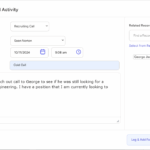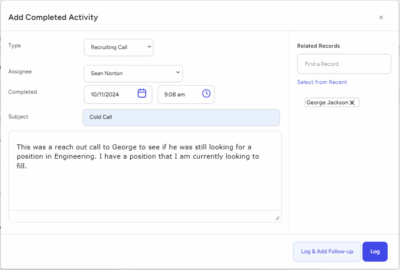In the fiercely competitive landscape of executive recruitment, the quest for top talent is an ongoing challenge. Executive recruiters and search consultants are tasked with not only identifying and attracting high-caliber candidates, but also ensuring a seamless and efficient recruitment process for their clients. This is where applicant tracking system analytics—or ATS analytics—can help!
In this era of digital transformation, the applicant tracking system emerges as a cornerstone technology, offering a wealth of data and insights to inform and enhance recruitment strategies. In this blog post, we will explore the intricate nuances of leveraging ATS data to optimize recruitment strategies, unlocking its power to bolster recruiter success and client satisfaction.
Understanding the Dynamics of ATS Analytics
At its core, the ATS serves as a centralized hub for managing candidate data throughout the recruitment lifecycle. However, its true value lies in its analytics and reporting capabilities, which offer a panoramic view of recruitment performance and candidate behavior. Let’s delve deeper into the multifaceted insights that ATS analytics can provide.
1. Unveiling Applicant Sourcing Insights: One of the primary functions of an ATS is to track the source of incoming candidates. By analyzing ATS data, recruiters can gain valuable insights into which sourcing channels are most effective in attracting qualified candidates. Whether it’s job boards, social media platforms, professional networks, or employee referrals, understanding the performance of each sourcing channel is crucial for optimizing recruitment efforts and allocating resources judiciously.
2. Navigating Candidate Pipeline Management: A well-managed candidate pipeline is the lifeblood of successful recruitment. ATS analytics offer real-time visibility into the status of candidates at various stages of the recruitment process, from initial application to final offer acceptance. Recruiters can track candidate progression, identify potential bottlenecks, and forecast hiring timelines with greater accuracy, ensuring a smooth and efficient recruitment workflow that meets client expectations.
3. Evaluating Performance Metrics: Tracking the performance of recruitment campaigns and job postings is essential for assessing their effectiveness. ATS analytics provide a plethora of metrics, including application conversion rates, time-to-fill, cost-per-hire, and quality-of-hire indicators. By analyzing these metrics, recruiters can evaluate the ROI of their recruitment efforts, identify areas for improvement, and refine their strategies to achieve better outcomes.
4. Promoting Diversity and Inclusion: Diversity and inclusion have become central tenets of modern recruitment practices. ATS analytics can play a pivotal role in monitoring progress in these areas by providing insights into candidate demographics, such as gender, ethnicity, and veteran status. Recruiters can track diversity metrics, identify gaps or biases in their recruitment processes, and implement targeted initiatives to foster a more diverse and inclusive workforce for their clients.
Leveraging ATS Analytics and Recruitment Data Insights
Armed with the wealth of insights gleaned from ATS analytics, executive recruiters and search consultants can embark on a journey to optimize their recruitment strategies. Let’s explore some strategic approaches for leveraging ATS data to drive recruitment success.
1. Refining Sourcing Strategies: By analyzing ATS data on candidate sourcing channels, recruiters can identify the most effective channels for attracting top talent. Armed with this knowledge, recruiters can allocate resources more strategically, focusing their efforts on the channels that yield the highest-quality candidates. Additionally, ongoing analysis and experimentation with different sourcing channels allow recruiters to adapt and refine their strategies over time, ensuring a steady influx of qualified candidates.
2. Streamlining Candidate Screening Processes: ATS data can provide valuable insights into the characteristics and attributes of successful candidates. By analyzing data on candidate profiles, qualifications, and behaviors, recruiters can develop more targeted screening criteria and workflows. Leveraging AI-powered screening tools within the ATS can further enhance efficiency and accuracy in candidate evaluation, enabling recruiters to identify the best-fit candidates more effectively.
3. Accelerating Time-to-Fill: Time-to-fill is a critical metric in recruitment, and ATS data can offer valuable insights into areas for improvement. By analyzing data on candidate progression through the recruitment pipeline, recruiters can identify bottlenecks and inefficiencies that may be prolonging the hiring process. Implementing strategies to streamline workflows, reduce administrative tasks, and improve communication with candidates can significantly accelerate time-to-fill and enhance the overall candidate experience.
4. Enhancing Diversity and Inclusion Efforts: ATS data can serve as a powerful tool for promoting diversity and inclusion in recruitment. By monitoring diversity metrics and analyzing candidate demographics, recruiters can assess the inclusivity of their recruitment processes and identify areas for improvement. Implementing diversity-focused initiatives, such as targeted outreach programs, inclusive job descriptions, and bias-free screening processes, can help attract a more diverse candidate pool and foster a culture of inclusion within client organizations.
Harnessing the Power of ATS Data to Drive Recruiter Success
The effective utilization of applicant tracking system data is not merely a tactical advantage but a strategic imperative for executive recruiters and search consultants. Here are some overarching principles for harnessing the power of ATS data to drive recruiter success and client satisfaction.
1. Embrace a Data-Driven Mindset: In today’s data-driven world, success in recruitment hinges on the ability to leverage data to drive informed decision-making. Executive recruiters and search consultants must cultivate a mindset that prioritizes data collection, analysis, and interpretation. By embracing a data-driven approach, recruiters can gain actionable insights into recruitment performance, candidate behavior, and market trends, enabling them to make strategic decisions that drive better outcomes for their clients.
2. Invest in Technology and Training: As technology continues to evolve, recruiters must stay abreast of the latest advancements in ATS platforms and analytics tools. Investing in advanced ATS systems with robust analytics capabilities can provide a competitive edge in the recruitment marketplace. Moreover, providing ongoing training and professional development opportunities for recruiters to enhance their data analysis skills is essential for maximizing the value of ATS data and driving continuous improvement in recruitment strategies.
3. Foster Collaboration and Knowledge Sharing: Collaboration and knowledge sharing are foundational pillars of success in recruitment. Encouraging recruiters to share insights, best practices, and success stories with their peers fosters a culture of learning and innovation within the organization. By leveraging collective expertise and experience, recruiters can generate new ideas, solve complex recruitment challenges, and drive better outcomes for their clients.
4. Adapt and Evolve: The recruitment landscape is constantly evolving, and recruiters must be agile and adaptable in their approach. Monitoring industry trends, technological advancements, and shifting candidate preferences enables recruiters to stay ahead of the curve and proactively adjust their strategies as needed. By remaining flexible and responsive to change, recruiters can position themselves for long-term success in a competitive marketplace.
Elevating Recruitment Excellence Through ATS Data Insights
Optimizing recruitment strategies with ATS data insights is not just a tactical endeavor but a strategic imperative for executive recruiters and search consultants. By unlocking the power of ATS analytics, recruiters can gain unparalleled visibility into recruitment performance, candidate behavior, and market dynamics. Leveraging these insights enables recruiters to refine sourcing strategies, streamline candidate screening processes, accelerate time-to-fill, and enhance diversity and inclusion efforts.
Embracing a data-driven mindset, investing in technology and training, fostering collaboration and knowledge sharing, and adapting to changing market dynamics are essential components of a successful recruitment strategy in today’s digital age. By harnessing the power of ATS data, executive recruiters and search consultants can drive recruitment excellence, achieve better outcomes for their clients, and maintain a competitive edge in the dynamic and ever-evolving world of executive recruitment.








